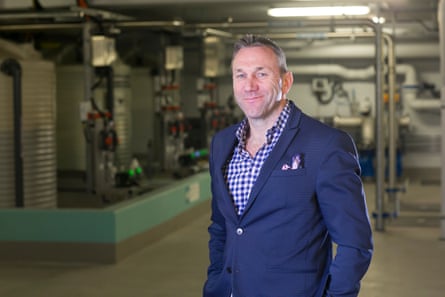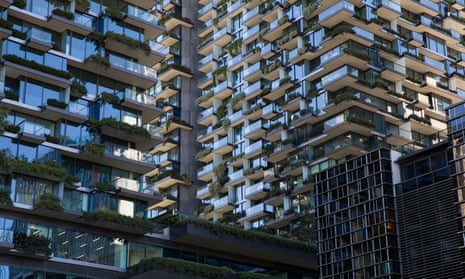In the basement of a Sydney housing development is the world’s largest water recycling plant in a residential building.
Normal apartments put more than 90% of the water they consume back into the sewer. But thanks to the recycling plant, units in Central Park, built on the site of the old Carlton brewery close to the CBD, return just 3%.
According to councils and water experts, such plants will be essential as Sydney’s population grows – making sure that precious water resources are used sustainably, and that the city is resilient to drought, storms, and even terrorist attacks.
The recycled water from the plant, which serves Central Park’s more than 2,000 units, is clean enough to drink. But with community sentiment not quite ready for consumption of water recycled from sewage, drinking water is bought from Sydney Water, to top up the recycled water used for most other things.
As a result of the Central Park project – as well as others including those at Green Park and Barangaroo – Australia is quickly becoming a world-leader in water recycling.
But according to the industry, academic water researchers, environmentalists, Sydney city council and others, a technical decision by NSW pricing regulator Ipart (the independent pricing and regulatory tribunal) has the potential to kill the burgeoning industry overnight.
“If the Ipart determination is allowed to proceed in its current form, the recycled water market in urban areas is likely to be decimated,” a coalition of developers, councils, environmentalists, academics and building certifiers said in a letter to NSW premier, Gladys Berejiklian in May this year.

Terry Leckie is founder of Flow Systems, the company behind the recycling plant at Central Park and a dozen other communities in NSW. He is even more blunt about the impact of the decision. “Overnight they have shut down the water recycling industry,” he says.
In a decision made final in July, Ipart ruled that recyclers would no longer receive wholesale rates (technically called “non-residential” rates) from Sydney Water for their fresh water and sewage access. Instead they will be subject to a “retail minus” pricing structure.
Under such a scheme, the pricing of water for the recycler would be set so that the incumbent – in this case Sydney Water or Hunter Water – has its profits maintained. So whether they are serving a resident behind a water recycling plant, or a resident in any other apartment, regulations will ensure Sydney Water make the same profit from that customer.
As a result, the recycler will get charged the normal retail rate for every customer they have, minus an estimate of the savings they are providing for Sydney Water.
Existing schemes won’t be automatically thrown on to the new pricing structure, but can be at the request of Sydney Water.
Ipart estimates the cost to recyclers will increase up to fourfold. But according to Flow Systems, the company behind the recycling plant at Central Park, that change could mean they end up paying more than 10 times for the services.
“There doesn’t seem to be any basis for why they would be increasing our costs 1,000%,” says Leckie.
The final figure will depend on the precise way that Ipart counts costs and savings that recyclers provide to the water networks – something that remains a matter of dispute between the parties.
An Ipart spokeswoman told Guardian Australia a tenfold increase in prices was not plausible but Flow Systems say their estimates have been thoroughly analysed and independently tested.
When releasing the final determination in July this year, Ipart said its decision was intended to “enhance innovation and efficiency” in the water market – which surprised industry, since they say increasing their costs seemed a bad way to do that.
But Ipart noted its decision was also balancing the demands of the incumbent water service providers – Sydney Water and Hunter Water.
In addition to allowing new entrants they also needed to ensure that Sydney Water and Hunter Water “continue to have sufficient revenue to service their customers”, said Ipart chair Peter Boxall in a media release in July.
Retail-minus schemes are designed to make sure the incumbent service provider keeps its same margin for every customer – regardless of how they get their water service.
Sydney Water has welcomed the determination, saying that before the change, other customers in the network were subsidising people with water recycling.
“Ipart’s determination has set prices which minimise the subsidy all customers pay for new water market entrants. This means customers will not be required to subsidise the emerging competitive water market,” a Sydney Water spokeswoman told Guardian Australia.
An Ipart spokeswoman told the Guardian that price regulation, left as it was, would have allowed water recyclers to undercut Sydney Water by simply buying fresh water from them at wholesale rates, and selling it at a rate lower than what Sydney Water is forced to charge.
But since Ipart recognised that water recycling plants can provide savings to Sydney Water – by putting less of a burden on their infrastructure – they decided that the exact price that each recycler pays would be determined on a case-by-case basis.

Flow Systems insists that means the company won’t be able to effectively bid for tenders in new residential developments, since they won’t know the price they will have to pay for water services until after the tender is awarded.
“Firstly, the fact there is no price for recycled water means businesses cannot price up jobs. How do we compete for a tender when we don’t know the price of the water? We would need an asterisk against the price saying subject to an Ipart review,” says McLean.
“Secondly, the length of the scheme specific review creates an unacceptable time risk. Currently Ipart licensing to become a local utility takes 18 months or more. Now we will need to add a minimum of four months to this. So we are looking at a two-year process all up – if we are lucky – to license one scheme,” says McLean. “What kind of messages does that send to councils and developers wanting sustainable water solutions?”
The issue may be resolved by a review committed to by the state coalition government, who have been seen as supporters of the water recycling industry.
A spokesperson of the NSW energy and utilities minister, Don Harwin, says they are concerned about the pricing determination. “There may be perverse incentives for recycled water users that discourage sustainable practices, which both save water and money.”
A review that examined potential barriers to cost-effective recycled water initiatives was recommended by the 2017 Metropolitan Water Plan, and was committed to by the NSW government in June this year.
Industry and the City of Sydney have called on the pricing determination to be put on hold until that point, and are requesting that the government intervene to do so.
Ipart says such a move is not needed since they think their determination “is an important step to facilitating efficient entry and competition in the water market”.
Councils – or Sydney city council at least – and industry groups are equally concerned about Iparts move.

Jonathan Cartledge from Green Buildings Council of Australia, is deeply concerned the ruling limits the sustainability that buildings can achieve and says it ignored recycling’s system-wide benefits.
“When we look at the water market as a whole, the burden recycling will take off the whole market is significant,” says Cartledge. “If you want to avoid enormous capital investments in the future it makes sense to make the most efficient use of what you have.”
“This pricing determination is really unfortunate,” says Chris Derksema, sustainability director at Sydney council. “It will kill off the recycled water industry in Sydney.”
Derksema says it’s not fair that new water services – to new buildings or land releases – provided by Sydney Water get the cost of the new infrastructure spread-out across the customer base of the entire network.
“But if you’re going to provide recycled water to a new development, that has to stand alone just on the income to the new development,” he says.
“We think it should be treated as a resilience measure across the whole of Sydney Metro, and therefore the cost of recycled water projects should be spread across the whole system, not just the new development.”
The idea of spreading the cost of a private resilience measure across the whole network is not entirely new.
During the extended drought at the start of the century, Sydney’s water reserves fell to unprecedented lows. The NSW government then spent $1bn on a desalination plant, whichsince 2012 has been mothballed with about half a billion dollars spent keeping it maintained. In 2015, the plant was damaged in wild weather, with repairs expected to continue until 2018.
Seen as an important part of Sydney’s water infrastructure, the cost of the plant was spread across all users by an uplift in their rates.
According to Ipart, the typical customer in Sydney is paying about $100 a year for the plant.
Agreeing with Sydney council, Lisa McLean, executive manager of corporate affairs at Flow Systems, says by the same reasoning, recycled water is a much better candidate to have its costs spread-out across all users.
She argues recycled water plants can provide much more water than the desalination plant, and they can do it in a decentralised way, meaning the system is less susceptible to the effects of things like storms, which have damaged the existing desalination plant.
Sydney’s will need to accommodate 2 million more people over the next two decades. Without large-scale sustainability measures, that will put enormous pressure on its ageing water infrastructure.
Ipart’s pricing determination means Sydney Water has exclusive access to continue profiting at its current rate from that growth, regardless of how sustainably they do that.
According to the water recycling industry, they should be given a go at servicing that growth in a more sustainable way.
“Why should Sydney Water have exclusive access to growth – or obligation to serve that growth when there are better business models that can do it at half the cost, more sustainably and faster?”
“We’re in a stage of super-growth,” says Derksema. “We think recycled water is absolutely essential to deliver not only Sydney city’s vision but also the Sydney Metro vision.”
McLean says the issue is becoming urgent. “The NSW water sector needs to make a transition to next generation water infrastructure and services – we cannot continue to invest in water management solutions that are 75 to 100 years old,” she says.
Leckie agrees. “Western Sydney is dry, the heat island effect is plaguing town centres and we’re pumping out enough water to fill Sydney harbour every year. It’s last century – and it’s not sustainable.”

Comments (…)
Sign in or create your Guardian account to join the discussion